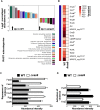Functional and Proteomic Analysis of Streptococcus pyogenes Virulence Upon Loss of Its Native Cas9 Nuclease
- PMID: 31507572
- PMCID: PMC6714885
- DOI: 10.3389/fmicb.2019.01967
Functional and Proteomic Analysis of Streptococcus pyogenes Virulence Upon Loss of Its Native Cas9 Nuclease
Abstract
The public health impact of Streptococcus pyogenes (group A Streptococcus, GAS) as a top 10 cause of infection-related mortality in humans contrasts with its benefit to biotechnology as the main natural source of Cas9 nuclease, the key component of the revolutionary CRISPR-Cas9 gene editing platform. Despite widespread knowledge acquired in the last decade on the molecular mechanisms by which GAS Cas9 achieves precise DNA targeting, the functions of Cas9 in the biology and pathogenesis of its native organism remain unknown. In this study, we generated an isogenic serotype M1 GAS mutant deficient in Cas9 protein and compared its behavior and phenotypes to the wild-type parent strain. Absence of Cas9 was linked to reduced GAS epithelial cell adherence, reduced growth in human whole blood ex vivo, and attenuation of virulence in a murine necrotizing skin infection model. Virulence defects of the GAS Δcas9 strain were explored through quantitative proteomic analysis, revealing a significant reduction in the abundance of key GAS virulence determinants. Similarly, deletion of cas9 affected the expression of several known virulence regulatory proteins, indicating that Cas9 impacts the global architecture of GAS gene regulation.
Keywords: CRISPR-Cas; Cas9; Streptococcus pyogenes; bacterial virulence; group A Streptococcus; pathogenesis; proteomics; regulation.
Figures





Similar articles
-
Endopeptidase PepO Regulates the SpeB Cysteine Protease and Is Essential for the Virulence of Invasive M1T1 Streptococcus pyogenes.J Bacteriol. 2018 Mar 26;200(8):e00654-17. doi: 10.1128/JB.00654-17. Print 2018 Apr 15. J Bacteriol. 2018. PMID: 29378883 Free PMC article.
-
Virulence Role of the GlcNAc Side Chain of the Lancefield Cell Wall Carbohydrate Antigen in Non-M1-Serotype Group A Streptococcus.mBio. 2018 Jan 30;9(1):e02294-17. doi: 10.1128/mBio.02294-17. mBio. 2018. PMID: 29382733 Free PMC article.
-
Functional and Transcriptome Analysis of Streptococcus pyogenes Virulence on Loss of Its Secreted Esterase.Int J Mol Sci. 2022 Jul 19;23(14):7954. doi: 10.3390/ijms23147954. Int J Mol Sci. 2022. PMID: 35887300 Free PMC article.
-
CRISPR-Cas in Streptococcus pyogenes.RNA Biol. 2019 Apr;16(4):380-389. doi: 10.1080/15476286.2019.1582974. Epub 2019 Mar 11. RNA Biol. 2019. PMID: 30856357 Free PMC article. Review.
-
Bacterial CRISPR/Cas DNA endonucleases: A revolutionary technology that could dramatically impact viral research and treatment.Virology. 2015 May;479-480:213-20. doi: 10.1016/j.virol.2015.02.024. Epub 2015 Mar 7. Virology. 2015. PMID: 25759096 Free PMC article. Review.
Cited by
-
Alternative functions of CRISPR-Cas systems in the evolutionary arms race.Nat Rev Microbiol. 2022 Jun;20(6):351-364. doi: 10.1038/s41579-021-00663-z. Epub 2022 Jan 6. Nat Rev Microbiol. 2022. PMID: 34992260 Review.
-
Efficient and rapid one-step method to generate gene deletions in Streptococcus pyogenes.Microbiol Spectr. 2024 Oct 3;12(10):e0118524. doi: 10.1128/spectrum.01185-24. Epub 2024 Aug 20. Microbiol Spectr. 2024. PMID: 39162539 Free PMC article.
-
The intricate pathogenicity of Group A Streptococcus: A comprehensive update.Virulence. 2024 Dec;15(1):2412745. doi: 10.1080/21505594.2024.2412745. Epub 2024 Nov 5. Virulence. 2024. PMID: 39370779 Free PMC article. Review.
-
The CRISPR-Cas Mechanism for Adaptive Immunity and Alternate Bacterial Functions Fuels Diverse Biotechnologies.Front Cell Infect Microbiol. 2021 Jan 28;10:619763. doi: 10.3389/fcimb.2020.619763. eCollection 2020. Front Cell Infect Microbiol. 2021. PMID: 33585286 Free PMC article. Review.
-
Analysis of genetic structure and function of clustered regularly interspaced short palindromic repeats loci in 110 Enterococcus strains.Front Microbiol. 2023 Apr 24;14:1177841. doi: 10.3389/fmicb.2023.1177841. eCollection 2023. Front Microbiol. 2023. PMID: 37168121 Free PMC article.
References
-
- Ashbaugh C. D., Warren H. B., Carey V. J., Wessels M. R. (1998). Molecular analysis of the role of the group A streptococcal cysteine protease, hyaluronic acid capsule, and M protein in a murine model of human invasive soft-tissue infection. J. Clin. Invest. 102 550–560. 10.1172/jci3065 - DOI - PMC - PubMed
Grants and funding
LinkOut - more resources
Full Text Sources

